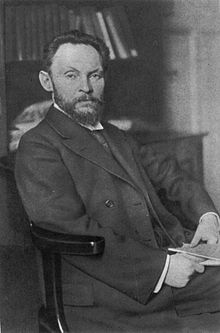Martin Freund

Martin Freund (August 13, 1863 in
Goethe-Universität Frankfurt am Main
.
Life
Freund was born the son of a Jewish merchant. After graduating from the
University of Breslau and the Humboldt University of Berlin in 1881. He received his doctorate in 1884. (contribution to the knowledge of malonic acid). During his studies he became a member of the Akademischer Naturwissenschaftlicher Verein zu Breslau in 1881.[1] He was assistant to Hermann Wichelhaus and lecture assistant to August Wilhelm von Hofmann. In 1888 he habilitated in Berlin and in 1895 joined the Physikalischer Verein in Frankfurt am Main as a lecturer, where he headed its chemical laboratory. From 1905 he was a lecturer at the Akademie für Sozial- und Handelswissenschaften (Academy for Social and Commercial Sciences). In 1914 he became full professor of chemistry at the faculty of natural sciences of the newly founded University of Frankfurt[2] and director of the chemical institute. Freund was a confidant of Fritz Haber, to whose wife he was related.[3]
At the chemical institute he maintained close ties with industry (e.g. the companies
Work
Freund dealt with
aromatic Hydrocarbons. With Edmund Speyer, he first synthesised the opioid oxycodone,[5] which was subsequently marketed as the analgesic Eukodal by Merck.[6]
Miscellaneous
The Letter acids (1-naphtylamine-3,5-disulfonic acid), a coupling component of dye chemistry, is incorrectly assigned to Martin Freund in the literature.[7] However, the name goes back to a patent of Louis Freund (St. Ludwig, Upper Alsace) of 1883,[8] it was transferred to BASF after registration.
Literature
- Entry in Winfried Pötsch, Annelore Fischer, Wolfgang Müller: Lexikon bedeutender Chemiker, Harri Deutsch 1989
References
- ^ Bericht über das II. Decennium des Akad. Naturwissenschaftlichen Vereins zu Breslau. Breslau 1894.
- ^ Ludwig Heilbrunn: Die Gründung der Universität Frankfurt A. M., Joseph Baer & Co 1915, p. 232.
- ^ Margit Szöllösi-Janze: Fritz Haber, 1868-1934: a biography, C. H. Beck, Munich 1998, p. 146, ISBN 9783406435485.
- ^ Physikalischer Verein Frankfurt, Historisches
- Chemiker-Zeitung, Vol. 44, Dr. Alfred Hütig Verlag Heidelberg, 1920 pp. 296. - preparation from 1920
- ^ Pötsch et al. Lexikon bedeutender Chemiker, Harri Deutsch 1989, p. 157. - Alexander Sennig, Elsevier's Dictionary of Chemoethymology, 2007. - John Andraos, Named reagents, catalysts and compounds, York University 2014,pdf
- ^ Louis Freund, Verfahren zur Darstellung von Amidonaphtalindisulfosäuren und von Azofarbstoffen aus denselben, German Patent No. 27346 of 24 February 1883.
